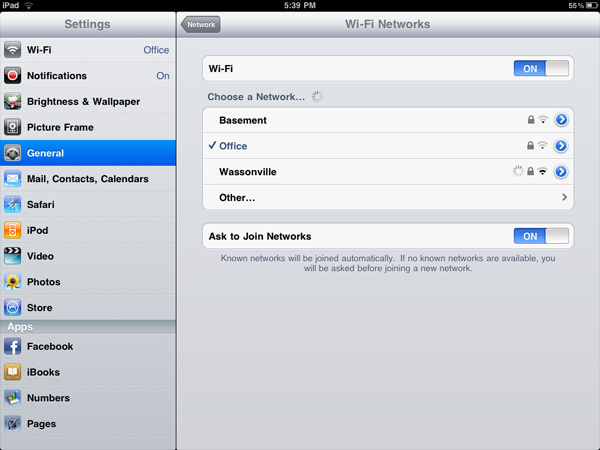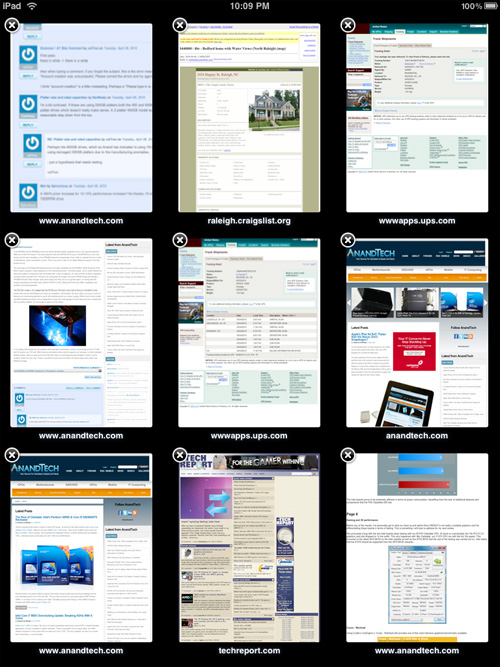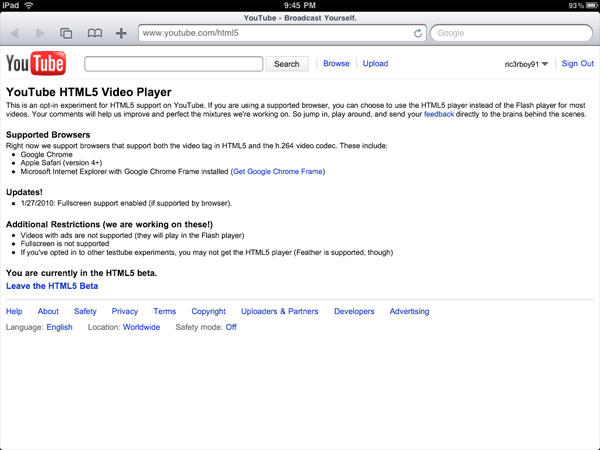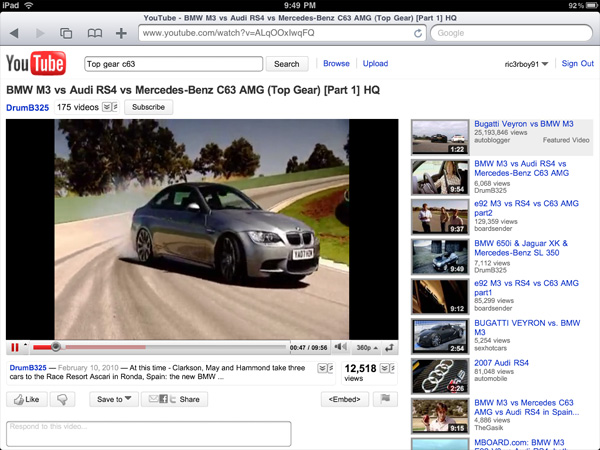Apple's iPad - The AnandTech Review
by Anand Lal Shimpi, Brian Klug & Vivek Gowri on April 7, 2010 9:39 PM EST- Posted in
- Smartphones
- Mac
- Apple
- iPad
- Mobile
WiFi
Many iPad users have been complaining about poor WiFi performance. What I have seen is the iPad doesn't seem to like to let go of a poorly performing access point in favor of another known access point with much better signal strength. Apple indicates that the iPad may not rejoin a known dual-band access point after coming out of sleep. I'm not sure whether my issue falls under Apple's KB article or not because the iPad will join my other networks, it just doesn't pick them as aggressively as I'd like.

Which one of these would you choose?
I've seen smartphones do this as well and it is a problem on my MacBook Pro. The more mobile the device however, the more annoying poorly calculated handoff timing is. Not to mention that because the iPad runs the same OS as the iPhone, there's no way to quickly switch between WiFi access points from the home screen.
The Killer App - Web Browsing
Reading web pages on the iPad is great. The 4:3 aspect ratio gives you a nice column for text heavy websites and landscape mode works well for wider layouts. It's a great tool for browsing the web and sharing what you find with others sitting around you. I can even see it being perfect for web designers working on building websites together.

Navigation is wonderful thanks to the touch screen and web sites look gorgeous thanks to the pricey LCD. Scrolling is super smooth, and it’s so much more comfortable reading articles away from a desk or without the added bulk of a laptop. It’s relaxed computing.
I'm a bit torn on this one because although I love browsing on the iPad, I'm not a fan of using it to write lengthy responses to comments on AnandTech. Quick responses are fine, it’s the longer ones that I don’t like drafting on the iPad. What I usually end up doing is reading the comments on the iPad and responding to them from my desktop. Did I mention that the iPad was a luxury?

Tabbed browsing isn't supported but you can have multiple browsers and slowly switch between them
The difference in screen size and resolution between the iPad and iPhone really makes itself felt inside Safari. Where in the iPhone you end up in stripped down mobile versions of websites, the iPad is capable of displaying a regular webpage in full-fledged glory. And because of the processing horsepower in the A4 SoC, the iPad has no problems rendering these full pages (more on this later). Part of the reason is because processor-heavy Flash objects are skipped over entirely, but doing so keeps the browsing experience fluid, which is arguably more important in a device like this.
So how does the iPad deal with content-rich sites that depend on mixed media elements? It's mixed, but overall pretty well. Pages like the new AnandTech, Autoblog, and Engadget are perfect, with the exception of the blank space wherever there should be embedded Flash objects. (There's no more blue Lego of Flash as there is on the iPhone to let you know when you're missing out.) Things get more interesting when you start hitting HTML5 video-enabled websites.

One of the first things I tried was the YouTube HTML5 beta. Yes, I know there's a YouTube app, but it's always nice to know that you can get the desktop version of YouTube working in Safari. Except, it isn't quite that simple. Reading through the HTML5 Beta page, there's one line that makes all the difference: "Videos with ads are not supported (they will play in the Flash player)." Which essentially means, if you ever want to watch an official music video or movie trailer (almost all of them have ads), you're hosed. Stick to the more off the road stuff (old Top Gear clips and various Indian music videos are good bets) and you should be okay, but it remains kind of annoying to go to a video page and be greeted with an empty hole where the video should have been. I'm hoping that Google will recognize the potential of a browser-based YouTube and disable ads when viewing on the iPad, but that remains to be seen.

Sites built around HTML5 video (or recently converted to HTML5 video in the run up to the iPad launch) work as advertised. ESPN has made the switch, and I was impressed at how seamlessly the experience translated from a normal computer. The New York Times also uses HTML5 video on their website, and it behaves just as it would in a desktop browser.

As far as social networking and communication websites go, the classic versions of Facebook, Twitter, and the Google web app suite all work to varying degrees. Twitter has a fairly simple desktop interface which translates over to the iPad flawlessly. Facebook functions well, though some of the buttons are a bit small. Also, the photo uploader doesn't work on the iPad, and while Facebook Chat does work, it remains fixed on the page, even if you scroll down. Nonetheless, it's far better than the touch optimized version of Facebook on the iPhone. It will be interesting to see how the Facebook developers utilize the extra screen space when creating the Facebook for iPad application. If it behaves like a slightly more touch optimized version of the full Facebook (instead of the icon-based iPhone app), it has the potential to be very user-friendly.

Google is another story entirely. For Gmail users, the iPad-optimized version of Gmail is awesome - you get the same dual pane message view like the Mail app, but with Gmail's signature threaded messaging included.

Google Docs is also optimized for iPad viewing. Note - viewing, not editing. There is no way as of yet to open a document in the desktop view, so it isn't possible to edit or create a new document. Highly disappointing, since full Google Docs compatibility would have been a killer feature on the iPad. If Google sees fit to rectify this problem by adding a mode to open a document in desktop view (and thus retain the ability to edit a document), it will be great. Google Talk Mobile is the same as on iPhone, except bigger, so you end up with a lot of wasted screen space. iGoogle Mobile is again the same as on iPhone, except larger, but switching to the desktop version of iGoogle fixes that problem. Some of the more advanced Google gadgets don't work, but the Gmail and RSS feeds work, as does the Weather gadget. The Google Chat sidebar makes it tempting to use the IM feature, but the experience is sadly broken. The chat windows are, like Facebook Chat, fixed on the page, and the text sometimes gets cut off on the edge of the screen. It's not enjoyable to use, but it will work in an emergency.
Google's iPad web services overall present an optimistic picture, highlighted by the Gmail application. As iPad-specific optimization finds its way to the other web apps, the Google suite could prove to be a valuable feature in the iPad. While web-consumption is a highlight of the iPad, interactive Web 2.0 sites do need work on the developer side to showcase the true capabilities of the platform. Full fledged web-browsing on the iPad ends up painting a similar picture to the rest of the device - there's a lot of potential in the device waiting to be tapped by continued development of the platform.










108 Comments
View All Comments
Anand Lal Shimpi - Wednesday, April 7, 2010 - link
I definitely appreciate the corrections :) Fixed!Take care,
Anand
odditude - Friday, April 9, 2010 - link
Bottom of P12: "Most developers just got access to the iPad on " - unfinished fragmentafkrotch - Thursday, April 8, 2010 - link
I found a bunch of errors in the article, but I chalked it up to him trying to use the iPad for actual work. Something it apparently sucks at.strikeback03 - Friday, April 9, 2010 - link
lol, I thought the article might have been a little rushed, kinda like the iPad. Great insight and content, but could have stood for a little more editing.CyberMonk - Wednesday, April 7, 2010 - link
According to Apple, you're incorrect about the iPad not having an oleophobic coating. From the iPad's tech specs page: "Fingerprint-resistant oleophobic coating"solipsism - Wednesday, April 7, 2010 - link
3rd-party accessory are allowed. Bluetooth keyboards already work with it and Apple licenses the iPod Dock Connector port so there is nothing stopping anyone else from selling their own keyboard, dock, or whatever, which I hope they do as the one Apple supplies has no option for folding down for easy travel.You can even use a simple USB-A(f)-to-USB-A(f) coupler for syncing your photos instead of paying for Apple's adapters. There are other options that already exist in this arena for USB.
Grump642 - Wednesday, April 7, 2010 - link
Think I will hold on till the HP Slate comes out. It will have most of the things on it that the iPad is missing.afkrotch - Thursday, April 8, 2010 - link
If the HP Slate runs Win7, I'd be all over it. I picked up a HP TM2, but the touchpad was broken on it. I went for a replacement, but none available. I'm waiting for more to come in stock, hopefully that's before the Slate comes out.I tend to jump right into purchases and I'd rather see how the Slate does. If it comes out before the TM2 comes in stock, that might not happen.
joe_dude - Wednesday, April 7, 2010 - link
That was a very detailed review. Only disagree on the gaming aspect. While the touch interface is cool, the CPU, GPU & memory seriously limits its potential. Others have already mention that.http://www.gamesradar.com/f/real-gamers-review-the...
Nothing against retro-gaming, but Worms, C&C, RE4, Scrabble, etc. are netbook quality at best.
ekul - Wednesday, April 7, 2010 - link
Anand,An excellent article as usual. While most of the ipad reviews have been quite through you have managed to discuss elements of the device no one else has touched on.
That said I have to disagree with your plea for a moorestown cpu. Even with moorestown being so much more efficient than regular atom based systems it can't touch a cortex a8 for idle or load power draw. Combine that with smaller packaging for arm, lower costs and true SoC designs and it isn't even a contest. The price is lower performance but I'll take the trade for battery life.
Keeping ipad the same architecture as existing iphone OS devices is a big bonus as well, lowering development costs for both apple and app developers. ARM is also providing an excellent upgrade path from a8 to the a9 SoCs that are sampling now and should be in devices shortly.
Once there is a true SoC design based on atom it might be worth considering but for now it's just not ready